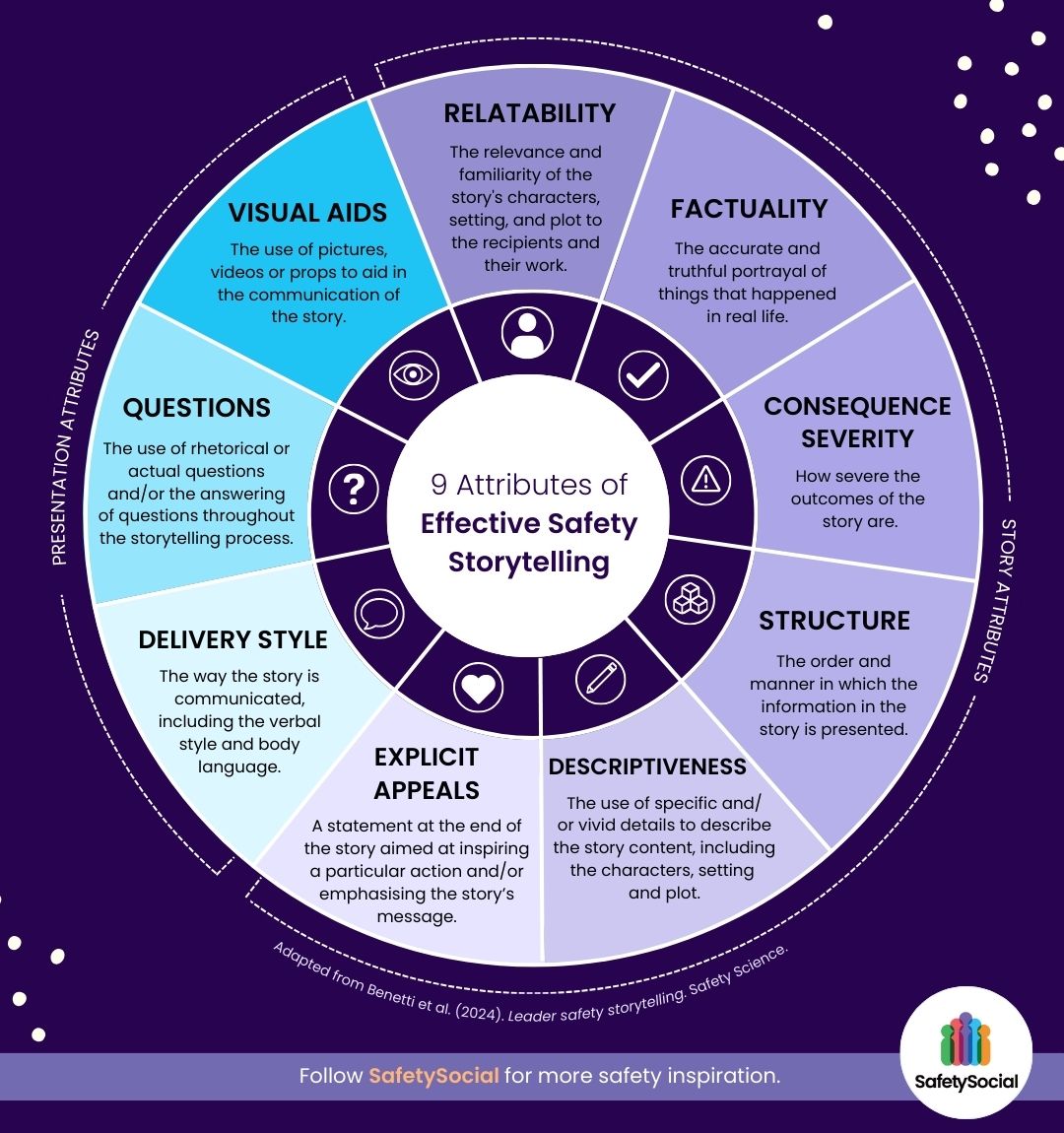Ever wonder why some stories stick with you while others fade into the background? Turns out, the way a story is told can make all the difference—especially when it comes to safety at work. A recent study published in Safety Science uncovers the magic behind effective safety storytelling, revealing how leaders can use this age-old technique to keep their teams engaged with safety.
The Art of Safety Storytelling
Storytelling isn’t just for bedtime or campfires—it’s a leadership superpower. But here’s the catch: not all stories are created equal. The study, titled ‘Leader safety storytelling: A qualitative analysis of the attributes of effective safety storytelling and its outcomes‘ dives deep into the nuts and bolts of what makes a safety story truly effective, offering leaders a framework to craft tales that not only captivate but also educate.
Why It Matters: Now, you might be thinking, “That’s great, but does it really work?” The answer is a resounding yes! The study found that when leaders tell safety stories well, they don’t just communicate—they connect. Workers see their leaders as more approachable, trustworthy, and committed to safety. Plus, their stories boost safety behaviours, knowledge, motivation, and attitudes among the team. Talk about a win-win!
So, what’s the secret sauce?
Attributes of Effective Safety Storytelling
The research identified two key categories of attributes that make safety storytelling impactful: Story Attributes and Presentation Attributes. Together, these elements create a powerful tool for leaders to communicate safety messages effectively.

Story Attributes
To create a compelling safety story, it’s not just about what you say but how you craft the narrative. These attributes focus on the content and structure of the story itself, ensuring that the message is clear, relatable, and memorable. The goal is to create a narrative that resonates deeply with the audience, making the safety message not just understood but felt. There’s six key attributes in this category.
1. Relatability
A great safety story connects with the audience on a personal level. When workers see their own experiences reflected in the story, it resonates more deeply, making the safety message more impactful. Workers found stories more impactful when they recognised the setting, tasks, or machinery involved. Stories set in familiar industries, geographical locations, or involving known tasks were particularly effective. Connecting with the protagonist also enhanced relatability, making the story feel more personal and engaging.
2. Factuality
Factuality is all about grounding the story in truth. Participants in the study emphasised that real, factual stories were more effective than those that were merely plausible. Leaders who shared true stories, often based on their own experiences, found that these stories resonated more with their audience, making the safety message more credible and impactful.
3. Consequence Severity
Highlighting severe consequences, such as major injuries or fatalities, made safety stories more effective. Stories that depicted serious outcomes grabbed the audience’s attention and underscored the importance of safety practices. This attribute shows that safety storytelling differs from other types of storytelling, as it often requires a focus on the potentially grave outcomes of unsafe behavior.
4. Structure
A well-organised story with a clear beginning, middle and end helps the audience follow along and grasp the main message. Participants noted that stories were more effective when they were cohesive, clearly outlining what happened, the outcomes, where things went wrong, and how they were fixed. Additionally, brevity and succinctness were key—stories needed to be to the point to maintain effectiveness.
5. Descriptiveness
Vivid, detailed descriptions of the setting, plot, and characters enhance the story’s impact by making it more memorable. Participants indicated that specific, often graphic details helped them visualise the story, embedding the safety message more deeply in their memory. The more clearly a story paints a picture, the more likely it is to resonate with the listener.
6. Explicit Appeal
Including a clear, direct appeal at the end of the story significantly increased its effectiveness. An epilogue-like statement that explicitly connected the story to the audience’s own work environment or safety practices helped reinforce why the story was important. This explicit appeal made sure that the audience understood the relevance and takeaways of the story, ensuring that the safety message was clear and actionable.
Presentation Attributes
Even the most compelling story can lose its impact if not delivered well. Presentation Attributes focus on the delivery of the story, ensuring that it is engaging, interactive, and memorable. These elements help bring the story to life, making it not just something the audience hears, but something they experience. There’s three key attributes in this category.
7. Delivery Style
The delivery of the story is just as crucial as its content. Participants highlighted the importance of maintaining eye contact, using confident body language, and adjusting voice tone to fit the story. A captivating tone, animated facial expressions, and dynamic interaction were key to holding the audience’s attention and making the safety message resonate.
8. Questions
Integrating questions into the storytelling process enhances engagement. Leaders who paused to ask or respond to questions about the story’s content or emotional impact found that it kept the audience involved and stimulated their thinking. Workers also valued the use of questions, noting that they made the storytelling experience more interactive and personal.
9. Visual Aids
The use of visual aids such as pictures, videos, and diagrams made safety stories more impactful. Visuals helped the audience to better grasp the reality of the situation being described, reinforcing the story’s message and making the safety lesson more tangible and memorable.
Impact on Safety Compliance and Participation
Great safety storytelling doesn’t just tell a tale—it drives action. The research shows that effective leader safety communication—especially through storytelling—can significantly enhance both safety compliance and safety participation. By making safety messages relatable and memorable, leaders can inspire workers to not only follow the rules but also take an active role in creating a safer workplace
Safety Compliance refers to those must-do safety behaviors, like wearing personal protective equipment (PPE). These are the non-negotiables that keep workers safe day-to-day.
Safety Participation involves going above and beyond the minimum requirements. This could include attending voluntary safety meetings, suggesting improvements, or helping others with safety procedures.
The Bigger Picture
This isn’t just about telling stories—it’s about transforming how we communicate safety in the workplace. Leaders, whether they know it or not, are already weaving stories into their safety messages. But with these new insights, there’s a chance to take it to the next level.
Imagine a workplace where safety isn’t just a set of rules but a shared narrative that everyone buys into. When leaders master the art of safety storytelling, they tap into more than just rule-following. When safety becomes part of the story, it’s no longer just a checklist—it’s a culture where everyone is motivated to contribute.
A Challenge to Leaders
Think about it: every great leader from history didn’t just give orders—they told stories. Stories that inspired, informed, and ignited action. Safety storytelling isn’t any different. It’s about turning safety from something workers have to do into something they want to do. When leaders master the art of safety storytelling, they’re not just improving compliance—they’re shaping a safer, more engaged workforce.
So, here’s the challenge: next time you’re about to roll out a safety initiative, don’t just present the facts—craft a narrative. Turn your safety briefings into stories that stick, inspire, and drive change. This isn’t just about keeping people safe today—it’s about creating a legacy of safety that lasts.
Want more curated content like this straight to your inbox? Subscribe to our newsletter. 👇



